Related Research Articles

Anatolia, also known as Asia Minor, is a large peninsula in Western Asia and is the western-most extension of continental Asia. The land mass of Anatolia constitutes most of the territory of contemporary Turkey. Geographically, the Anatolian region is bounded by the Turkish Straits to the north-west, the Black Sea to the north, the Armenian Highlands to the east, the Mediterranean Sea to the south, and the Aegean Sea to the west. Topographically, the Sea of Marmara connects the Black Sea with the Aegean Sea through the Bosporus strait and the Dardanelles strait, and separates Anatolia from Thrace in the Balkan peninsula of Southeastern Europe.

The Bosporan Kingdom, also known as the Kingdom of the Cimmerian Bosporus, was an ancient Greco-Scythian state located in eastern Crimea and the Taman Peninsula on the shores of the Cimmerian Bosporus, centered in the present-day Strait of Kerch. It was the first truly 'Hellenistic' state, in the sense that a mixed population adopted the Greek language and civilization, under aristocratic consolidated leadership. Under the Spartocid dynasty, the aristocracy of the kingdom adopted a double nature of presenting themselves as archons to Greek subjects and as kings to barbarians, which some historians consider unique in ancient history. The Bosporan Kingdom became the longest surviving Roman client kingdom. The 1st and 2nd centuries AD saw a period of a new golden age of the Bosporan state. It was briefly incorporated as part of the Roman province of Moesia Inferior from 63 to 68 AD under Emperor Nero, before being restored as a Roman client kingdom. At the end of the 2nd century AD, King Sauromates II inflicted a critical defeat on the Scythians and included all the territories of the Crimean Peninsula in the structure of his state.
The Indo-Parthian Kingdom was a Parthian kingdom founded by Gondophares, and active from 19 CE to c. 226 CE. At their zenith, they ruled an area covering parts of eastern Iran, various parts of Afghanistan and the northwest regions of the Indian subcontinent. The rulers may have been members of the House of Suren, and the kingdom has even been called the "Suren Kingdom" by some authors.
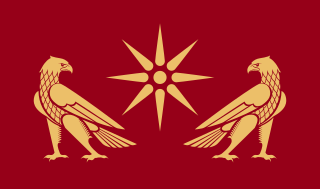
Armenia, also the Kingdom of Greater Armenia, or simply Greater Armenia sometimes referred to as the Armenian Empire, was a kingdom in the Ancient Near East which existed from 331 BC to 428 AD. Its history is divided into the successive reigns of three royal dynasties: Orontid, Artaxiad and Arsacid (52–428).

Artaxias I was the founder of the Artaxiad dynasty of Armenia, ruling from 189 BC to 160 BC. Artaxias was a member of a branch of the Orontid dynasty, the earlier ruling dynasty of Armenia. He expanded his kingdom on all sides, consolidating the territory of Greater Armenia. He enacted a number of administrative reforms to order his expanded realm. He also founded a new capital in the central valley of the Araxes River called Artaxata (Artashat), which quickly grew into a major urban and commercial center. He was succeeded by his son Artavasdes I.

Sophene was a province of the ancient kingdom of Armenia, located in the south-west of the kingdom, and of the Roman Empire. The region lies in what is now southeastern Turkey.

The Artaxiad or Ardaxiad dynasty ruled the kingdom of Armenia from 189 BC until their overthrow by the Romans in AD 12. Their realm included Greater Armenia, Sophene and intermittently Lesser Armenia and parts of Mesopotamia. Their main enemies were the Romans, the Seleucids and the Parthians, against whom the Armenians conducted multiple wars.
The Orontid dynasty, also known as the Eruandids or Eruandunis, ruled the Satrapy of Armenia until 330 BC and the Kingdom of Armenia from 321 BC to 200 BC. The Orontids ruled first as client kings or satraps of the Achaemenid Empire and after the collapse of the Achaemenid Empire established an independent kingdom. Later, a branch of the Orontids ruled as kings of Sophene and Commagene. They are the first of the three royal dynasties that successively ruled the antiquity-era Kingdom of Armenia.

Corduene was an ancient historical region, located south of Lake Van, present-day eastern Turkey.
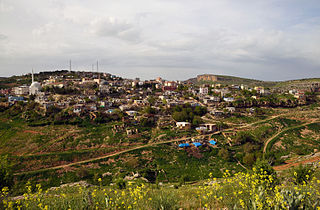
Eğil is a town and district of Diyarbakır Province of Turkey. As of 2018, the district's population is 23,369. The elected mayor Mustafa Akkul of the Peoples' Democratic Party (HDP) was dismissed on the 23 March 2020 and replaced by a trustee. The current Kaymakam is İdris Arslan.

Sames I, was the Orontid king of Sophene and Commagene, ruling around 260 BC.
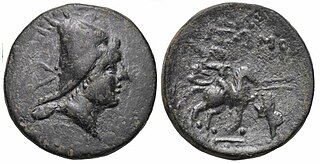
Arsames I seems to have taken control of Commagene, Sophene and Armenia in the year 260 BC after the death of his grandfather Orontes III, king of Armenia, and his father Sames, king of Commagene.
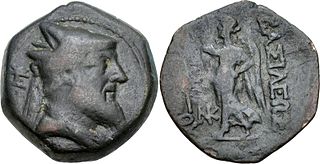
Xerxes was king of Sophene and Commagene from 228 BC to 212 BC. He was the son and successor of Arsames I.

Abdissares was the first king of Adiabene, ruling sometime in the first half of the 2nd-century BC. Scholarship initially considered him to be the ruler of Sophene, due to stylistic similarities between his coins and the ones in Commagene and Sophene. However, this has now been debunked. It has now been established that Abdissares' name—contrary to the Sophenian kings—was not of Iranian origin, but of Semitic, meaning "servant of Ishtar," a name primarily used by Semitic inhabitants. The goddess Ishtar enjoyed great popularity in the heartland of ancient Assyria, where Adiabene was located.
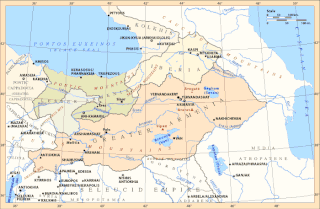
The Satrapy of Armenia, a region controlled by the Orontid dynasty, was one of the satrapies of the Achaemenid Empire in the 6th century BC that later became an independent kingdom. Its capitals were Tushpa and later Erebuni.

Scythia or Scythica was the Graeco-Roman name for a region of Eastern Europe corresponding to the Pontic steppe, which in antiquity was inhabited by the Scythians, who were an ancient Eastern Iranian equestrian nomadic people.

Pontus was a Hellenistic kingdom centered in the historical region of Pontus and ruled by the Mithridatic dynasty, which possibly may have been directly related to Darius the Great of the Achaemenid dynasty. The kingdom was proclaimed by Mithridates I in 281 BC and lasted until its conquest by the Roman Republic in 63 BC. The Kingdom of Pontus reached its largest extent under Mithridates VI the Great, who conquered Colchis, Cappadocia, Bithynia, the Greek colonies of the Tauric Chersonesos, and for a brief time the Roman province of Asia. After a long struggle with Rome in the Mithridatic Wars, Pontus was defeated. The western part of it was incorporated into the Roman Republic as the province Bithynia et Pontus; the eastern half survived as a client kingdom until 62 AD.

The Kingdom of Sophene, was a Hellenistic-era political entity situated between ancient Armenia and Syria. Ruled by the Orontid dynasty, the kingdom was culturally mixed with Greek, Armenian, Iranian, Syrian, Anatolian and Roman influences. Founded around the 3rd century BCE, the kingdom maintained independence until c. 95 BCE when the Artaxiad king Tigranes the Great conquered the territories as part of his empire. Sophene laid near medieval Kharput, which is present day Elazığ.
Orontes III was King of Armenia. In his reign he struggled for control of the Kingdom of Sophene with king Antiochus II Theos until being defeated in 272 BC and was forced to pay a large tribute which included 300 talents of silver and 1,000 horses and mules. Orontes III was subsequently murdered in 260 BC, whether at the instigation of King Antiochus II is not recorded. His son, Sames, continued to rule in Sophene.

The Central Bank Visitor Centre is a Centre and an interactive museum in Yerevan, Armenia dedicated to the activities of the Central Bank of Armenia, the monetary policy of Armenia, and the history of money. The museum was opened on 20 September 2011. It is located in the historic building of the Central Bank and occupies 2 floors.
References
- ↑ Marciak, Michał (2017-01-01). "Cultural Landscape of Sophene". Sophene, Gordyene, and Adiabene. Brill. pp. 56–112. doi:10.1163/9789004350724_004. ISBN 978-90-04-35072-4.